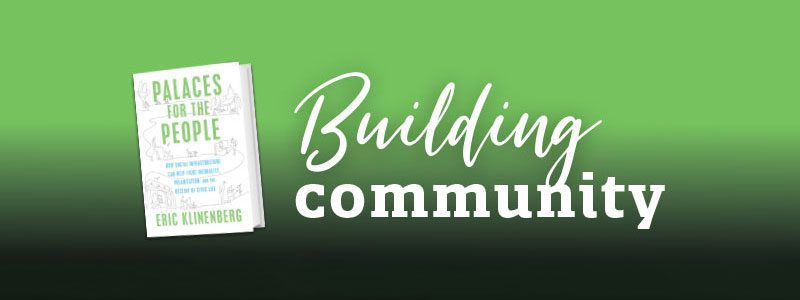Inspired by this summer’s One Book, One Oak Park selection Palaces for the People by Eric Klinenberg, we are asking about and sharing community members’ perspectives on social infrastructure. This is what Klinenberg calls “the missing piece of the puzzle; and building places where all kinds of people can gather is the best way to repair the fractured societies we live in today.”
More than 125 community members, Oak Park stakeholders, and public library staff met the author on June 5 at the Main Library. Watch and listen to the Facebook Live recording, which begins a few minutes into the program»
Share your thoughts now and read what others are saying to continue this conversation and build public knowledge around this topic.
Please note: submissions are no longer being accepted.
What others are saying
“Talking out the pedestrian mall was a huge step backwards for OP’s social infrastructure. We could have made the pedestrian mall pretty and put a pocket park where that tiny parking lot is. We could have had tables out, more benches. Kids would have a safe place to run around while their parents got coffee or went shopping. And people could have just hung out without having to buy anything. It could have been Thursday Night Out everyday.”
Pamela B.
“Because you encouraged email responses to Palaces for the People, I feel compelled to share a personal revelation — one that had its roots in early 20th century suburban Cicero. In his Chapter 2, “Safe Spaces,” the author addresses the neighborhoods where people are more attentive to their surroundings and, as a result, are safer and freer from crime and gun violence. That might not seem an especially remarkable observation, though cities tend to address high crime neighborhoods by increasing police presence. The author references this with the “broken window” theory — Pp. 60-61 — “that criminals perceive broken windows and other forms of neighborhood disorder as signals of weak social control and, in turn, as evidence that crimes committed there are unlikely to be checked.” However, it’s the author’s contention that, rather than increasing police presence, when attention is given to beautifying vacant lots and removing or remodeling vacant buildings that good things happen. That may not be especially surprising but when considering the 1924 Western Electric Study results which is frequently referenced as the ‘Hawthorne Effect” something else becomes apparent.”
Ron Solberg, Downers Grove
“This reference to the Western Electric study and the Hawthorne Effect for this book is mine, alone, and is not mentioned by the author. I may have originally become aware of the study in one or another college sociology class so many years ago. In brief this is it: The study was originally conceived to determine what effect a change in work environment had on productivity. The study addressed what changes occurred, for example, when lights were brightened. And, in fact, every time the lights were brightened, productivity did improve. Probably not so surprising — right? But then it was decided to see what would happen if the lights were dimmed, expecting that productivity would decrease. NOT SO! Productivity improved even more. What the heck was going on? The study concluded that employees were performing better when lights were both brightened and dimmed BECAUSE they thought the employer was watching them and was concerned about their well-being. So, could one conclude when the powers-that-be affect neighborhood changes — whatever they might be — that the people in that neighborhood would take it upon themselves to do better and assist in the neighborhood’s improvement? Of course, we’re not suggesting that any and all changes would work. Only, that when people think that someone out there really does care about them, they respond.”

